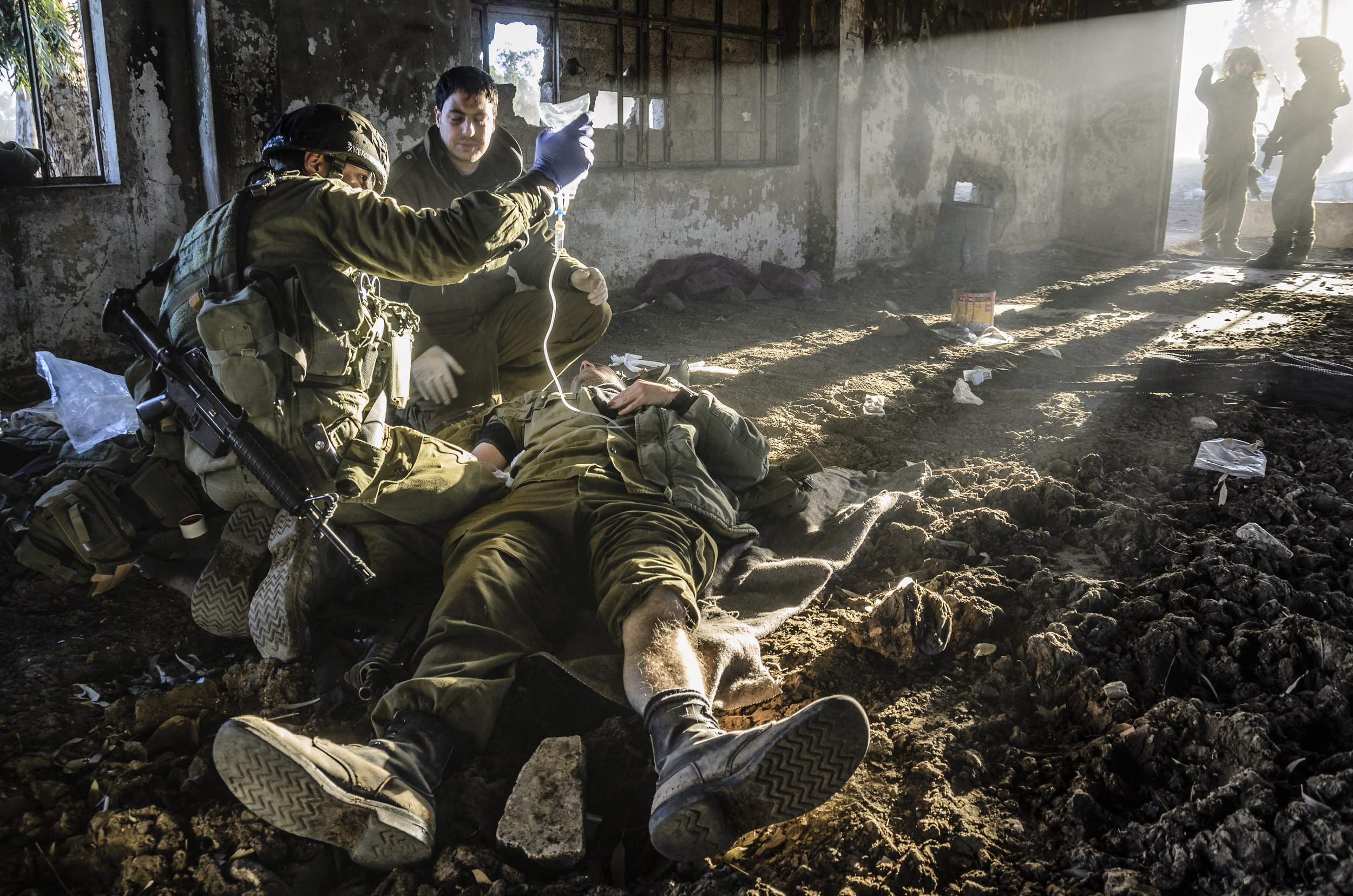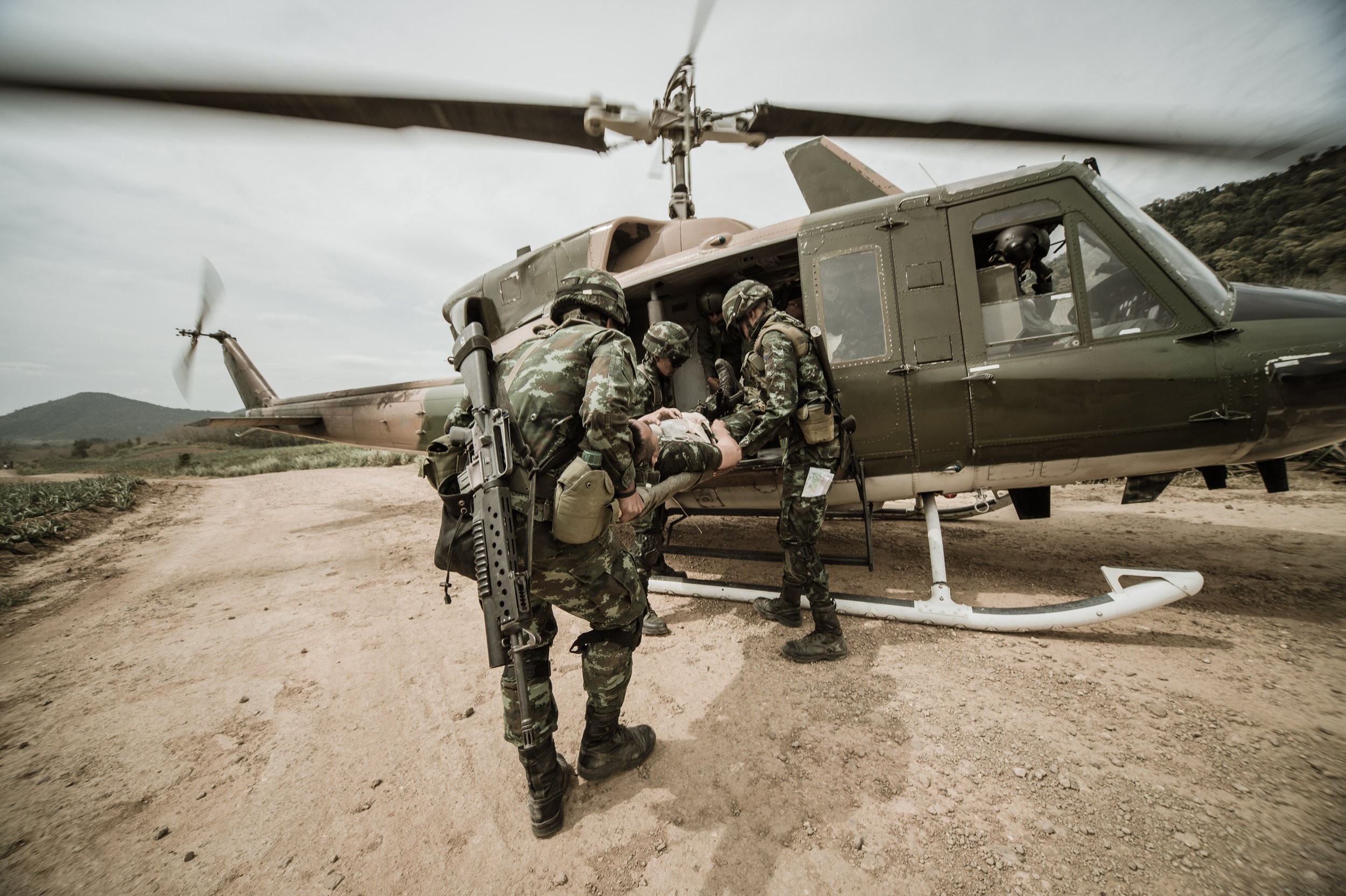
The Future of Combat Casualty Care
Originating with the military service of two of our co-founders as surgeons during Operation Enduring Freedom, Certus is driven by the need to make combat casualty care more effective and accessible. Our longstanding, productive relationship with the Armed Forces stretches back to early research and development conducted at Travis Air Force Base and continues with a strong history of DOD grant funding, creating technology and knowledge products that have already had clinical impact and will ultimately enhance critical care for service members everywhere.

Bringing Advanced Critical Care to the Battlefield
The concept behind Certus’s core technology, the Endovascular Aortic Control (EVAC) system, is a low-energy, single-use disposable catheter and controller that empowers field medics and advanced resuscitation teams to bring next-generation hemorrhage control capabilities to injured warfighters and extend their survival en route to the nearest medical facility or during prolonged field care (pFC) conditions.
Technology Highlights
Low energy
Powered by AA batteries, keeping the device operational is easy, even in some of the most remote parts of the world.Disposable unit
Unlike traditional critical care equipment, our device is built with simple and low-cost materials that are light and easy to transport.Artificial intelligence
The advanced computing capabilities of the EVAC system provides guidance for providers. In high stress situations, medics and other health care providers can rely on the embedded blood pressure sensors to measure and adjust interventions to meet the individualized needs of the patient, so they can focus on other aspects of tactical combat casualty care.Reliable sensors
Unlike standard fluid column sensors that are inaccurate 30% of the time and require more time and equipment for operation, our proprietary solid state sensors provide rapid, reliable, high-fidelity data to guide critical decisions in the field and during care en route.All-in-one
Once development of pending and pipeline products are complete, our PACC-MAN integrated critical care platform will offer provider-in-the loop automated care to stabilize polytrauma casualties, as well as provide continuous monitoring and medication, fluid, and blood delivery.
Technology Implications
Increase intervention time
Translational studies have shown that even in the most severe cases of trauma, EVAC partial occlusion technology can extend the time medical professionals have to intervene by 60 minutes or more. In scenarios that often require extended medevac times, particularly without air superiority, this extra time can make the difference between life and death.Reduce cognitive burden
In forward-deployed environments, medics and lightweight resuscitation assets are often limited by a lack of resources and manpower, placing a burden on providers that often negatively impacts patients’ outcomes. The intelligent algorithms in Certus technology provide precision care based on individual physiology on a minute-by-minute basis—all without the direct and continuous intervention by a medical professional. This provider-in-the-loop automated care reduces decision-making for providers and gives them more bandwidth to focus on other life-saving therapies.A trauma surgeon in your pocket
Certus technologies are built on years of research and experience in both the operating room and intensive care situations. We apply that knowledge to digital tools that can automate key aspects of critical care, putting surgeon-level expertise in the hands of military field medics and other medical providers with the touch of a button.Saving more lives
With a commitment to reduce potentially survivable deaths and the burden of survivorship, the DoD has a stated focus on next generation therapies to stop hemorrhage and improve prolonged field care. Certus technologies are specifically designed to address these stated knowledge and material gaps.
Dig Deeper into the Tech
Take a closer look at the technologies that Certus Critical Care is developing and discover how we are solving some of the most pressing problems facing critical care providers.
DOD Grant Funding History
The Certus story begins in Afghanistan in 2014 and stretches out over the last eight years of non-dilutive DOD grant funding. Learn about the origins of our ties to the U.S. military and discover how an ongoing relationship with the Military Health and Research Foundation has fueled our ground-breaking innovations.
2014
Deployment with Operation Enduring Freedom
Luke Neff, MD, and Tim Williams, MD, both members of the U.S. Air Force Task Force East, are assigned to Craig Joint Theater Hospital at Bagram Air Field, Afghanistan. They gained firsthand experience of the ongoing challenges of combat casualty care in austere environments.
2015
Research Begins at Travis Air Force Base
Redeploying back to Travis Air Force Base, Neff and Williams begin their early research around partial aortic occlusion and precision blood flow, paving the way for their medical device innovations. Austin Johnson, MD, PhD, a physician and researcher at UC Davis joins the research efforts as an outside collaborator, bringing his expertise in neuroscience and traumatic brain injury resuscitation to the team.
2015-16
DOD Intramural JPC6 FY16 (Physiology Aortic Occlusion)
Certus’s first grant investigated the effects of REBOA and EVAC on injury patterns above the point of aortic occlusion. The fundamental findings were that the heart, lungs, and brain are subjected to supranormal pressures with REBOA, which can cause additional damage. Maintaining highly regulated partial aortic flow with EVAC reduced some of those undesired side effects of endovascular hemorrhage control.
2016
Air Force 6.3-Concept Development FY15/16 Award
This research and development award provided $1.15M for initial prototyping of the earliest clinical grade EVAC catheters.
2017
Certus Critical Care, Inc. is Established
After an unsuccessful search for a strategic partner with a similar vision for developing the next generation of endovascular hemorrhage control catheters, the founders establish Certus Critical Care, a company that will carry the device to full commercialization.
2018-19
Air Force 59th Medical Wing FY19-22 (ARDS Detection/ Device Development)
This grant facilitated the initial prototyping and design of the VentRight monitor for detecting off-target ventilation, as well as the observational clinical trial of the device.
2020
Air Force 6.4/ MHRF Catheter/ Controller Refinement FY20
This grant supported the creation of the final design of the clinical grade EVAC catheter and controller.
2021
Joint Warfighter Medical Research Program
This grant enabled the final construction of the EVAC catheter and the creation of the FDA validation and verification package.
2022-25
Joint Warfighter Medical Research Program (PACC-MAN Development)
This ongoing grant will fund the refinement of Certus’s existing clinical grade pump technology to create a compact, low-power platform for Partially Automated Critical Care Management (PACC-MAN), an automated medication and fluid delivery system that relies on algorithms currently being utilized in large animal models.
Functioning on-the-go, our technologies have the potential to revolutionize the way trauma care is treated in combat zones.
Get to know our innovative technologies and why we built them.
From the battlefield to the bedside, we set out to create the critical care technology of the future and uncovered new scientific knowledge in the process. Find out why we created our life-saving technologies.
For decades, critical care medicine has suffered from limitations that affect the care people receive. Learn about the work we’re doing that could save thousands of lives from hemorrhage, cardiac arrest, stroke and more.


